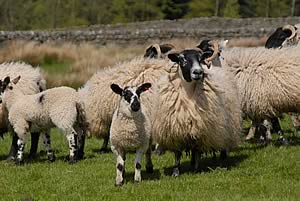 |
|||||||||
|
|||||||||||||||||||
|
|
Robust Defences Vital to Counter Major Parasite Threat Lamb producers across the country should be prepared to mount especially robust defences against internal parasites at grass this season to counter particularly high risk conditions for nematodirus, parasitic gastroenteritis and liver fluke infections.
This is the timely warning from EBLEX, the industry body for beef and lamb levy-payers in England, following the latest monthly National Animal Disease Information Service (NADIS) parasite forecast published in the past week.
While the cold winter may have reduced populations of pre-infective parasitic nematode larvae, the April forecast highlights the fact that older third stage larvae can survive prolonged periods of sub-freezing temperatures quite well. Against the background of larger over-wintering populations almost certainly resulting from last year’s combination of wet summer and dry autumn, this means that early lambs grazing this April are likely to be at increased risk of parasitic gastro-enteritis. At the same time, lower than average temperatures from December right through to early March are likely to have delayed the nematodirus hatch, leading to a high risk of May and June infections in main crop lambs. This contrasts with the moderately early hatch and well below average incidence of last season prompted by 2009’s mild February and March. Following the high incidence of liver fluke infection reported from flocks last year, chronic disease levels are also expected to be relatively high in ewes this spring. This, in turn, will lead to greater egg returns to pastures and fluke populations starting from even higher levels than last year, further increasing the potential for late summer and autumn problems if pasture conditions again favour snail proliferation. High parasite threat levels throughout the grazing season make well-planned and managed control programmes particularly vital this year, EBLEX stresses. As well as the most effective use of clean pastures at every opportunity, producers are advised to use faecal egg counts where feasible to assess the parasite challenge and target treatments; select their anthelmintics with care for the specific parasites they need to control; have sufficient stocks on hand at all times to enable prompt treatment whenever necessary; calibrate and maintain their drenching guns well; and ensure consistently accurate dosing on the basis of actual sheep weight. With-holding food for 12-24 hours before treatment has also been shown to improve the efficacy of both white and clear drenches. To provide the best possible guidance for the coming season, the BRP Beef and Sheep Parasite Control Guide has recently been updated as a comprehensive reference to currently available products and the parasites they control. This is available free of charge to levy payers through www.eblex.org.uk, while the latest NADIS parasite forecasts, together with valuable veterinary diagnostic and treatment advice, can always be obtained at www.nadis.org.uk.
|
||||||||||||||||||

|
|
||||||||||||||||||
| home | agri-services | pedigree
pen | news | dairy | beef | machinery property | organisations | site map |
|||||||||||||||||||

